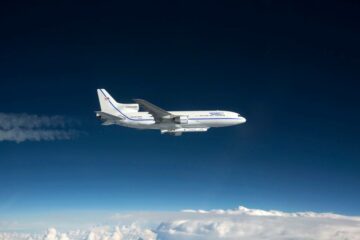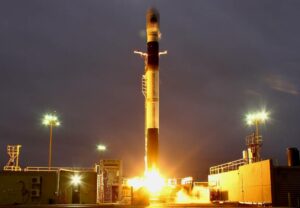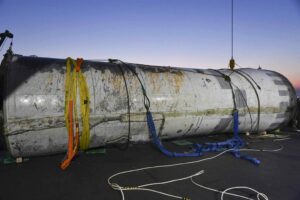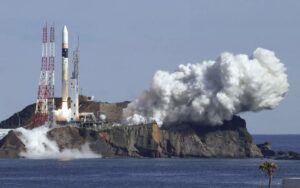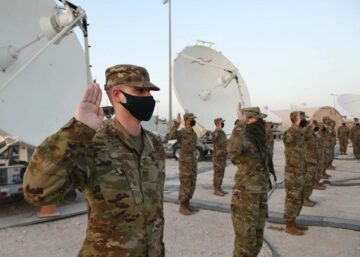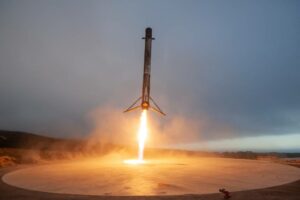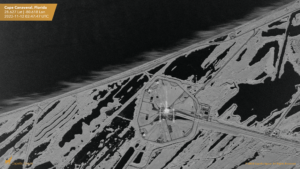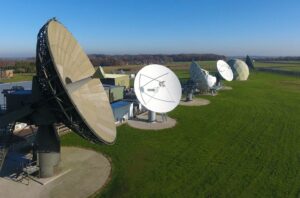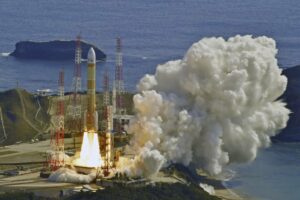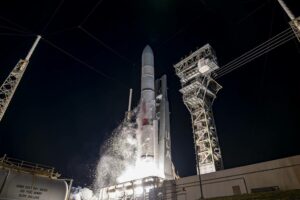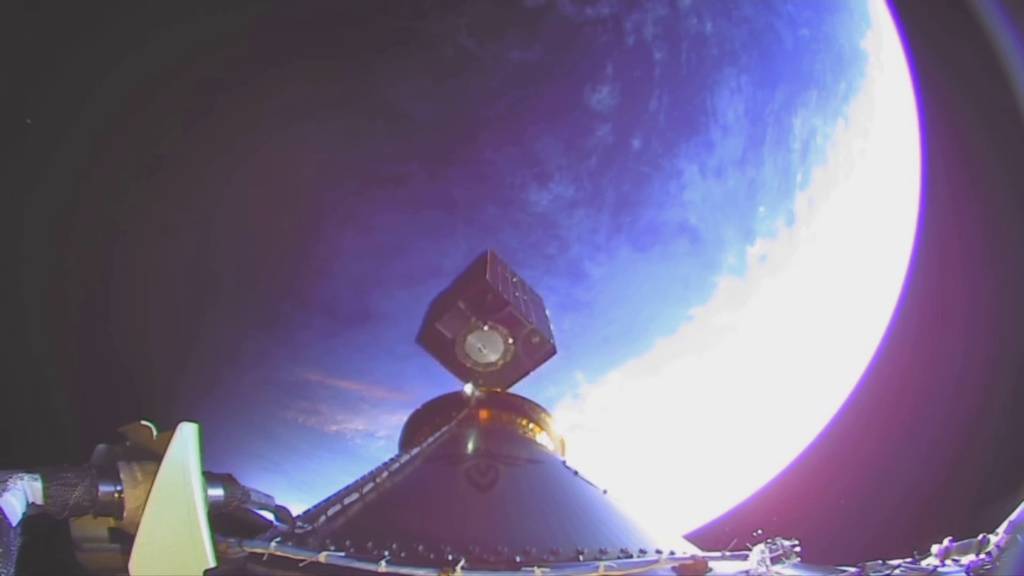
WASHINGTON — Firefly Aerospace’s Alpha rocket successfully launched the U.S. Space Force’s second operational tactically responsive space demonstration Sept. 14, setting a record for flying within 27 hours of receiving launch orders.
The Victus Nox mission, Latin for “conquer the night,” was meant to demonstrate the ability to rapidly acquire, build, integrate and launch a satellite. Boeing subsidiary Millennium Space Systems built the spacecraft, which flew from Vandenberg Space Force Base, in California.
“The success of VICTUX NOX marks a culture shift in our nation’s ability to deter adversary aggression and, when required, respond with the operational speed necessary to deliver decisive capabilities to our warfighters,” Lt. Gen. Michael Guetlein, head of Space Systems Command, said in a Sept. 15 statement.
SSC’s Space Safari program office led the demonstration in partnership with the command’s Rocket Systems Launch Program.
With the satellite now in orbit, the team will work to begin operating it in within 48 hours.
The Space Force chose Firefly and Millennium in 2022 to conduct the mission. Last month, the service notified the companies they had entered a “hot standby” phase, indicating the 24-hour launch window could open at any moment.
During that phase, Millennium sent the satellite from its facility in El Segundo, California, to Vandenberg, where the mission team tested, fueled and mated it to its launch adapter in less than 58 hours — a process that can take weeks or months for a standard launch.
The Space Force wants to have an enduring responsive space capability as soon as 2026, which would allow it to quickly launch satellites into space either to respond to an in-orbit threat or augment a degraded or destroyed system. That could mean having a spare satellite in orbit that could be turned on or maneuvered into position as needed, working with commercial partners to buy data in a crisis or, as in the case of Victus Nox, have a satellite on the ground that’s ready to be launched on demand.
The mission is the Space Force’s second tactically responsive space demonstration; the first flew in 2021 on a Northrop Grumman Pegasus XL rocket.
The service is making plans for a third launch, this time working with the Defense Innovation Unit. DIU announced Aug. 24 that the effort, dubbed Victus Haze, would focus on “end-to-end execution using commercial capabilities.”
Victus Nox was the third flight for Firefly’s Alpha rocket. Following this week’s mission, the company said it is preparing for several upcoming missions for NASA, the National Reconnaissance Office, Lockheed Martin and other customers.
“As our third flight, this mission further validates Firefly’s technology rigor, passion, and dedication that’s required to prevail as the leading responsive launch provider for both government and commercial customers,” Firefly’s Vice President of Launch Vehicles Adam Oakes said in a statement.
Courtney Albon is C4ISRNET’s space and emerging technology reporter. She has covered the U.S. military since 2012, with a focus on the Air Force and Space Force. She has reported on some of the Defense Department’s most significant acquisition, budget and policy challenges.
- SEO Powered Content & PR Distribution. Get Amplified Today.
- PlatoData.Network Vertical Generative Ai. Empower Yourself. Access Here.
- PlatoAiStream. Web3 Intelligence. Knowledge Amplified. Access Here.
- PlatoESG. Automotive / EVs, Carbon, CleanTech, Energy, Environment, Solar, Waste Management. Access Here.
- PlatoHealth. Biotech and Clinical Trials Intelligence. Access Here.
- ChartPrime. Elevate your Trading Game with ChartPrime. Access Here.
- BlockOffsets. Modernizing Environmental Offset Ownership. Access Here.
- Source: https://www.defensenews.com/battlefield-tech/space/2023/09/15/us-space-force-launches-victus-nox-responsive-space-mission/
- :has
- :is
- :where
- 10
- 14
- 15%
- 2012
- 2021
- 2022
- 2026
- 27
- 70
- a
- ability
- acquire
- acquisition
- Adam
- AIR
- Air Force
- allow
- Alpha
- an
- and
- announced
- any
- AS
- At
- Aug
- base
- BE
- begin
- both
- budget
- build
- built
- buy
- california
- CAN
- capabilities
- capability
- case
- challenges
- chose
- commercial
- Companies
- company
- Conduct
- could
- covered
- crisis
- Culture
- Customers
- data
- decisive
- dedication
- Defense
- deliver
- Demand
- demonstrate
- destroyed
- dubbed
- effort
- either
- el
- emerging
- Emerging Technology
- enduring
- execution
- Facility
- First
- flight
- flying
- Focus
- following
- For
- Force
- from
- fueled
- further
- Gen
- Government
- Ground
- had
- Have
- having
- head
- HOURS
- HTTPS
- images
- in
- indicating
- Innovation
- integrate
- into
- IT
- ITS
- jpg
- Last
- Latin
- launch
- launched
- launches
- leading
- Led
- less
- Lockheed Martin
- Making
- Martin
- mean
- meant
- Michael
- Military
- Millennium
- Mission
- missions
- moment
- Month
- months
- most
- Nasa
- National
- Nations
- necessary
- needed
- night
- now
- nox
- of
- Office
- on
- open
- operating
- operational
- or
- Orbit
- orders
- Other
- our
- partners
- Partnership
- passion
- Pegasus
- phase
- plans
- plato
- Plato Data Intelligence
- PlatoData
- policy
- position
- preparing
- president
- process
- Program
- provider
- quickly
- rapidly
- ready
- receiving
- record
- Reported
- reporter
- required
- Respond
- responsive
- rocket
- s
- Safari
- Said
- satellite
- satellites
- Second
- sent
- sept
- service
- setting
- several
- she
- shift
- significant
- since
- some
- Soon
- Space
- Space Force
- spacecraft
- speed
- standard
- Statement
- subsidiary
- success
- Successfully
- system
- Systems
- Take
- team
- Technology
- tested
- than
- that
- The
- they
- Third
- this
- threat
- time
- to
- Turned
- u.s.
- unit
- upcoming
- us
- using
- validates
- Vehicles
- vice
- Vice President
- wants
- was
- webp
- Weeks
- when
- which
- will
- window
- with
- within
- Work
- working
- would
- zephyrnet

